The Japan Aerospace Exploration Agency (JAXA) announced that Makoto Suwa, 47, and Ayu Yoneda, 29, who have undergone basic training to become astronauts, were officially certified. This is the first time in 13 years since 2011 that JAXA has certified astronauts, who will support space development in the future, with lunar activities in mind. At the press conference, the two expressed their joy and enthusiasm, saying, "We want to deliver our scientific results firmly to the earth" and "We want to convey the appeal of space to young people." At a press conference in February last year when they were selected as astronaut candidates, the two spoke passionately about their motivations for applying to become astronauts. They spoke without hesitation about the results of their training, giving a glimpse of subsequent growth.
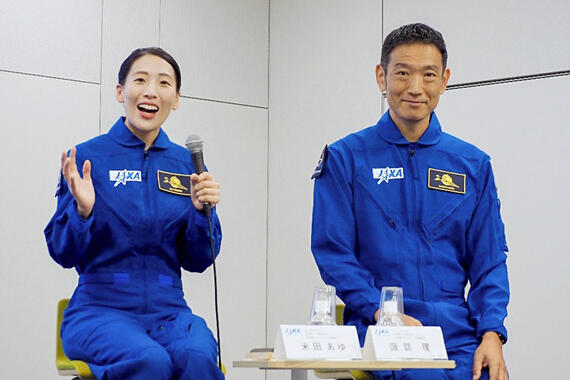
Enthusiasm for lunar exploration mission "ARTEMIS"
Previously, Suwa was a senior disaster prevention specialist at the World Bank and Yoneda was a surgeon at the Japanese Red Cross Medical Center. After being selected as astronaut candidates from 4,127 applicants, Yoneda joined JAXA in April last year and Suwa in July the same year. They received training in science and engineering and have knowledge of the International Space Station (ISS), survival techniques, physical training, languages, and interview handling, both in Japan and abroad.
The two new astronauts joined JAXA, increasing the number of active astronauts to seven. Since Naoko Yamazaki, 53, who flew her first 15-day flight in 2010, retired the following year, there were no female astronauts in the team. This situation was changed with Yoneda's certification.
The two will continue their training at the NASA's Johnson Space Center in Houston, Texas. Once a specific flight plan is determined through international coordination, training will begin accordingly.
The certificates were given to the two on the 21st of October last year. At a press conference held two days later in Tokyo, the two took the stage with radiant expressions on their faces. At the beginning, Suwa said, "Space development is in a transitional period, moving from the ISS to the age of exploration. There are also business prospects. I want to become an astronaut who can contribute while adapting to a changing environment. I want to deliver scientific results to the Earth." Yoneda expressed her resolve, "I want to think carefully about how we can play an active role as humanity heads for the Moon and Mars under the Artemis Project (international cooperation to explore the Moon). I want to be an astronaut who can convey to the younger generation the appeal of space and joy of working hard."
"Zero gravity was different from what I imagined" - looking back on the joys and hardships of training
Looking back on basic training, Suwa said that one of the most memorable experiences was the "parabolic flight," in which a pilot experiences a state of weightlessness inside the aircraft for a short period of time using a unique technique of aircraft flying. "What I actually experienced was quite different from what I imagined when I saw the images of astronauts floating on the ISS, and it was truly a strange sensation. When I turned my belly to the ceiling of the aircraft and did the movement of spinning around in a circle in zero gravity, I had the sensation that the ceiling suddenly became the floor, which was very interesting. It captured my imagination that this is going on all the time at the ISS."
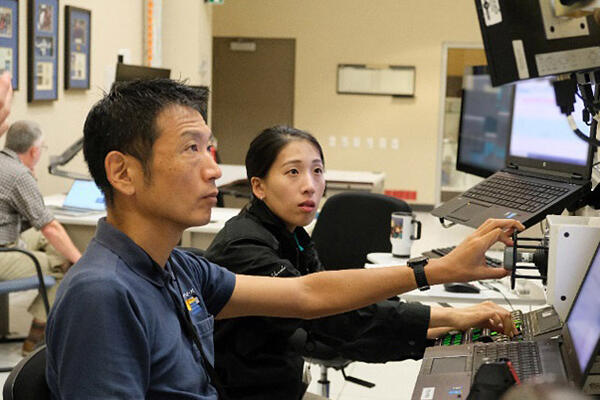
Courtesy of JAXA, the Canadian Space Agency, and Manned Space Systems Corporation
Yoneda spoke of a training exercise that simulates rapid decompression in a spacecraft. She said, "Hypoxia caused by rapid decompression can lead to the gradual loss of cognition and color vision without feeling any pain and loss of consciousness, which I felt I would not recognize if I did not know about it. If you feel it with your own body, rather than just listening to lectures, you can respond immediately. It was interesting to be able to actually train."
Meanwhile, Suwa found it difficult to complete the training required to fly an aircraft. "It was a multitasking experience, as you couldn't afford to neglect either communication or piloting." With the robotic arm, Yoneda said, "It took time to operate a limited number of cameras and to recognize cameras that could easily capture the arm's movements. The ISS orbits the earth in 90 min, so light and dark (day and night) alternate every 45 min. Sometimes it was easy to see and sometimes it was hard; so, overall, it was difficult."
The two continued to train together. Suwa said about Yoneda, "She understands things quickly. Even during lectures, she asked many questions from different perspectives than I did; additionally, because we have different backgrounds, it was very interesting." Yoneda said of Suwa, "During the emergency response training, he remained calm no matter what the situation was, which was a great help. When he is with other people, he can warm the atmosphere and bring laughter, and I learned a lot about communication skills." They praised each other.
Japanese going to the Moon surface as "first non-American"
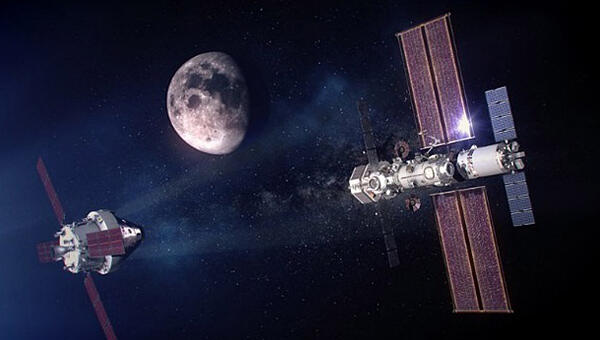
Provided by Albert Bertolin of NASA
An important stage in which the two are expected to act in the future is the Artemis Project. The U.S. is leading this project as a large-scale international space exploration following the ISS. The exploration will be the first manned lunar landing since Apollo 17 in 1972. "Gateway," a base above the Moon, will be constructed to conduct experiments and observations, and technological demonstrations will be performed with a view to future Mars exploration. Japan decided to join the project in 2019, with Europe and Canada also joining the project.
In April of last year, Japan and the US officially agreed that two Japanese will land on the moon under the Artemis mission. Japan will provide a manned lunar rover, while the US will consider landing the Japanese "as soon as possible." The Japanese will be the first non-Americans to land on the moon under the project. If realized, one of the JAXA astronauts, which includes Suwa and Yoneda, will set foot on the Moon surface. The basic training for the two included field training in geology to give them a background in lunar exploration. The pair may also have the opportunity to travel to low-Earth orbit bases, such as the ISS, including their first flight.
On the subject of lunar exploration, Suwa said, "I am truly happy to be able to undergo training while closely watching the technological development progress. Going to the Moon has scientific significance and is exciting in itself. I want to train hard while thinking about what I can do." Meanwhile, Yoneda said, "I am being forced to rethink what it will take to go to the Moon."
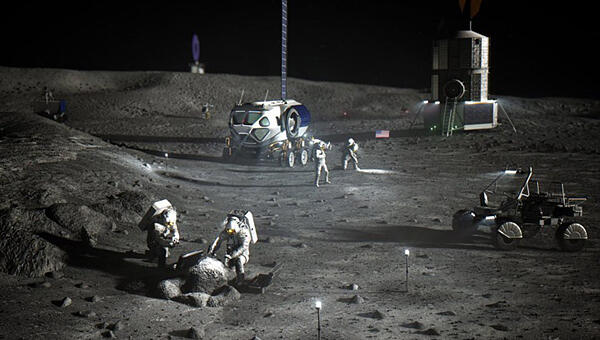
Provided by NASA
"I can't wait for the day when Japanese vehicle will run on the Moon"
The manned lunar rover to be provided by Japan for the Artemis Project is the "Lunar Cruiser." Two astronauts can live in the vehicle for approximately 30 days while driving and exploring the Moon surface. While rovers used in the US Apollo program half a century ago were unpressurized buggy-like vehicles, the Lunar Cruiser is a pressurized vehicle that allows occupants to live inside in a shirt. Toyota Motor Corporation is engaged in full-scale development, and Mitsubishi Heavy Industries, which has experience in the development of the Japanese Experiment Module "Kibo" for the ISS, is also collaborating with the company.
Regarding the Lunar Cruiser, Suwa said, "When I looked inside the mock-up (model), I felt that it was filled with wisdom, ideas, and technology that Japan has cultivated over the years. Although there are technical challenges to overcome before the project can be realized, it was heartening to see how much fun the people involved seemed to be having as they worked on the rover development. It is exciting to imagine it running on the Moon surface. The simulator experience was also interesting."
Yoneda commented, "I got the impression that a lot of thought had been put into making the astronauts' stay comfortable. Despite the limitations of internal space and various challenges associated with accommodating astronauts, it was impressive to see the developers not only using the technology they had cultivated over the years but also giving deep thought to new possibilities. I felt the enthusiasm of people from JAXA and private firms working together to promote space development. I can't wait, and of course I want to drive it."

It all started with "Science Expo" and "Mukai's biography."
Suwa was born in Tokyo in 1977. He was raised in Tsukuba City, Ibaraki Prefecture and graduated from the Graduate School of Geosciences at Princeton University, US. He joined the World Bank in 2014, after serving in Rwanda with the Japan Overseas Cooperation Volunteers and World Meteorological Organization (WMO). He worked on climate change and disaster prevention initiatives in Africa.
At a press conference conducted last February when he was selected as an astronaut candidate, Suwa said, "Being an astronaut has been my dream since I was really little. Through several experiences, the desire grew stronger." "Perhaps the first time I dreamed of being an astronaut was when I was in the third grade of elementary school, a science expo was held in my neighborhood (now Tsukuba City), and I begged my parents to take me there many times. I was most interested in science and space. Another was meeting the commander of Apollo 17 in the fifth grade". After that, he talked about how Toyohiro Akiyama became the first Japanese person to go to space on a Soviet spacecraft in 1990 and how Mamoru Mori became the first Japanese person to board the US Space Shuttle in 1992. He said, "I was attracted to the weight and sparkle of the words spoken by people who had been in space, and it renewed my desire to become an astronaut."
As Suwa became deeply involved in development overseas, he felt more strongly that the results of space development should be felt more widely around the world. He said, "I participated in the astronaut selection process partly because I felt I could contribute to Japan's leadership."
Yoneda, meanwhile, was born in Tokyo in 1995. She was raised in Kyoto City and graduated from the Faculty of Medicine, the University of Tokyo. After working at the University of Tokyo Hospital (Tokyo), she joined the Japan Red Cross Medical Center (Tokyo) in 2021 and was dispatched to Toranomon Hospital (Tokyo).
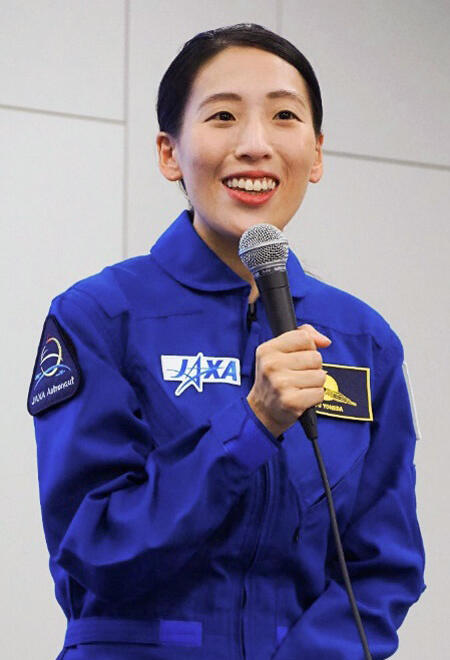
At a press conference conducted February 2023, Yoneda explained what aspired her to become an astronaut. "I read a manga biography of Chiaki Mukai, an astronaut, given to me by my father. I was greatly impressed by the way she looked at the Earth from space and was moved by her impressions, which led me to learn about this profession. I thought I could apply my experience as a doctor to understand changes in the human body in space." On the day JAXA announced its call for astronauts, she was feeling excited, and on her way home from the hospital where she worked, she happened to come across the sight of people watching a lunar eclipse. "The Moon is a place that everyone gazes upon and admires. It always sends gentle light to the Earth and watches over us. I want to take on the challenge, too," she said, and she was determined to do so.
"Relax my shoulders and try again!" Suwa succeeds in second attempt
Incidentally, Suwa applied for the previous astronaut recruitment in 2008. He was unsuccessful in the first round of selection, but his second attempt was successful. When training began in the July of the last year, the author asked Suwa, "Based on your self-evaluation, what do you think made the difference between passing or failing?" He looked puzzled and said, "That's a difficult question," but continued, "for the past 13 or 14 years, I have worked hard in the position I was given. Furthermore, this time, compared to the last time, I could really relax my shoulders. To be honest, my expectations were not that high. I was getting older. However, I took it with the mindset of putting everything I had done into this and having no regrets. I'm happy with the way it turned out."
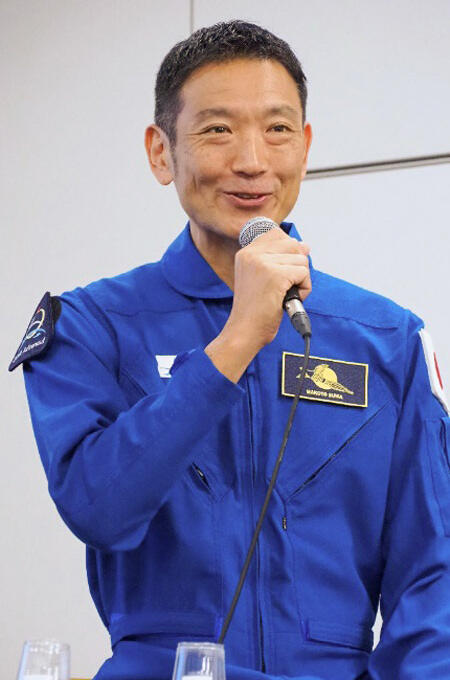
The last time humans set foot on the moon surface, 380,000 km from Earth, was in December 1972. For more than half a century, manned flights have been limited to few hundred kilometers above the Earth. To put it another way, except for extravehicular activities, we have been "holed up" in spacecrafts and space stations, just outside the thin skin of the Earth's atmosphere and have continued to conduct experiments and other activities. Building on the success of the ISS project, which has been continued through international cooperation, manned space development will once again take on an "exploration" character, entering a new dimension as people set foot on lunar wilderness. This exploration happens after a long gap for the US, a space powerhouse, and is an unexplored territory for Japan. Activities are qualitatively very different from those of previous astronauts. Despite the friendly atmosphere at this press conference, we must not forget that lives are at risk. Why go to the Moon? Why Japanese? We will be very excited the day we land on the Moon, but it will be important what we can feel and learn from it.
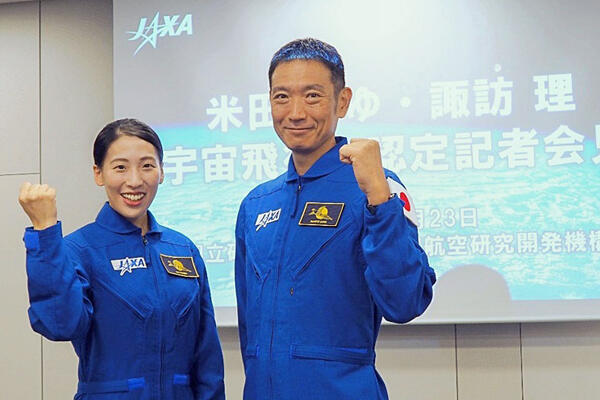
(KUSAKA Takeo / Science Portal Editorial Office)
Original article was provided by the Science Portal and has been translated by Science Japan.




